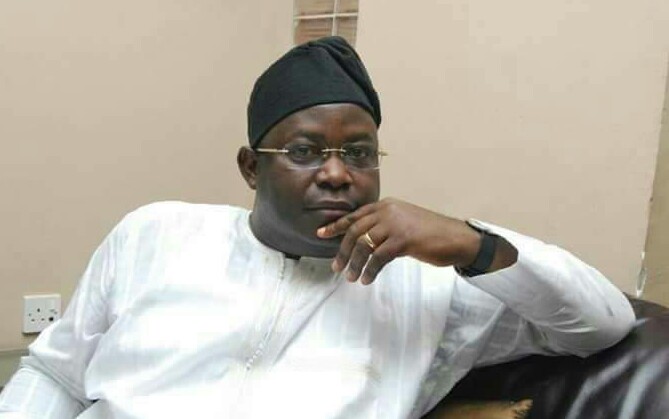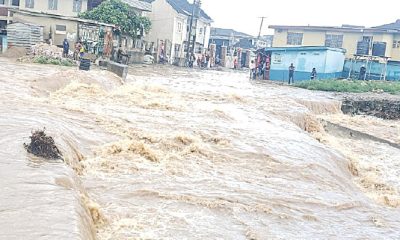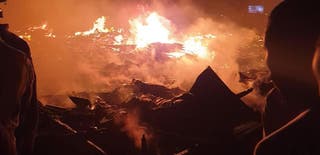News
NIPSS’s Intervention on Osun Tourism for Nigeria, State Economy Development
NIPSS’s Intervention on Osun Tourism for Nigeria, State Economy Development
Tourism has become a worldwide industry which is recognized as one of the top three constituents of world trade, ranking third after petroleum and the vehicle industries.
Osun state is said to be cultural and traditional centre of Yorubaland. Osun is blessed with attractive, natural and world class tourist sites. In the Yoruba nation, no state has the numerous eye-catching natural tourist sites like Osun. The state has not less than 60 tourism sites. Some of the tourism centres are historical and spiritual. Tourist centres like Osun Osogbo Sacred Groove, Osogbo, Oduduwa groove, Oranmiyan staff (both in Ile-Ife), Kiriji war site in Imesi-Il an Igbajo, Oluminrin waterfall in Erin-Ijesa, Ayinkunugba waterfalls in Oke-Ila, Imesi Mysterious caves and movement rocks are major tourist sites which can alone turn around the economy of the state.
The economic potentials of tourist centres in Osun have attracted the attention of the National Institute for Policy and Strategic Studies (NIPSS), Kuru, Jos. NIPSS, is understudying the economic values and fortunes of tourist sites, with a view to develop a strategic framework and policy for the Federal Government to explore the tourism potentials in the state for national and state economic development.

L-R: Special Adviser to Governor Rauf Aregbesola on Culture and Tourism, Mrs Taiwo Oluga, Tor Gowon Yaro, Mrs Zandra Agbor, Mr Asipita Umar (Leader of the NIPSS Team), Engineer Abimbola Daniyan, (Chairman of Osun Tourism Board)and Professor Sola Adeyanju at the Oluminrin waterfall, Erin-Ijesa, Osun state.
NIPSS did not just pick Osun for examination and analysis. Findings revealed that the attention of NIPSS was drawn to Osun tourism potentials by a participant of the Policy Strategy and Leadership Course (PSLC), Mr Tor Gowon Yaro who is the Executive Director of Foundation for Ethnic and Religious Tolerance. Yaro, who was sponsored by the Lagos State House of Assembly, passionately raised the issue of the tourism potentials of Osun.
According to a letter dated September 27, 2017 written to Governor Rauf Aregbesola by NIPSS, the issue generated a lot of intellectual engagement among course participants. The letter signed by the Managing Consultant, NIPSS, Mr Asipita Umar reads: “Participants agreed that Osun is a state whose history, rich heritage and mesmerizing attraction (Olumirin waterfalls, Osun Osogbo Sacred Grove, Oran,iyan Staff, Ife Bronze, Osogbo Arts and Metals and Great Food, etc) make it a fascinating, unique and outstanding tourism destination.
“The tremendous aura of tradition mixed with a touch of modernity that oozes from Osun state, which is appreciated as a hub of cultural renaissance (home of Oduduwa and cradle of the Yoruba race) presents a huge tourism potentials which the state government must exploit to the socio-economic benefits of its citizens.
“In view of the foregoing and within the context of the mandate of the National Institute, we have resolved to engage the state government on a project to do a detailed study of the tourism potentials of Osun state with a view to crafting a medium-to-long term state strategy for transforming that sector.
“The project will involve a programme of packaging each tourist site for greater local and international attraction, crafting a funding plan and a programme of marketing the tourism attractions of osun globally.”
On Monday November 11, NIPSS sent down a team to Osun to go round major tourist centres in the state for critical evaluation of the natural endowment. The team which was led by Umar had Professor Sola Adeyanju, Mrs Zandra Agbor and Tor Gowon Yaro (the mover of Osun tourism development at NIPSS) as members. Part of the tourist sites visited by the team was Oluminrin waterfall at Erin-Ijesa in Oriade Local Government of the state. Towering high, the cliff can be found within the community axis of Erin-Oke, Erin-Ijesha, and Erinmo. The fall was said to have been discovered in 1140 AD by Akinla, a granddaughter of Oduduwa, when the people of Ife were migrating to Erin-Ijesha.
Olumirin waterfall has seven falls, each one providing a new and different perspective. The waterfall forms a large pool of water on the ground, surrounded by vegetation. The steps needed to reach a next level are not specified. Climbing them may be a daunting task, but it is a rewarding one as it gives an awe-inspiring experience. The Olumirin waterfalls, according to the Chairman, Osun Tourism Board, Engineer Abimbola Daniyan, was the most visited tourist site in Nigeria as at November of 2014, saying from January to November, it had grossed 50,000 holiday makers.
Also, the NIPSS team visited the ancient Kiriji war site at Imesi-Ile, in Obokun Local Government and Igbajo in Boluwaduo local government. The site is the place where the 16-year-old war between Ibadan and the combined forces of Ekiti and Ijesha took place. ‘Kiriji’ was an onomatopoeic name given to the war from the thunderous sound of the cannons the Ekitis and Ijeshas, under the command of Ogedengbe, purchased and used in abundance during the war.
The site was made up of many historical places: Ogendengbe Stone Stool, Ogun shrine, Fejeboju stream, Ibu Latoosa, Treaty peace site, Faragbota tree and Abaa Latoosa (Village of Latoosa). Ogendengbe stone stool was the commanding tower for the army of Ekiti Parapo and they waited patiently and steadfastly for the mystical command and communication from their commander’s stool which is about 1000meters to the war site. Ogun shrine was where Ogendengbe usually consulted gods on how the war will look like and it was the enquiry portal. Fejeboju stream was formally called Eleriko which supplied water to both the Ibadan and Ekiti parapo confederate camps. But history recorded that during the war, victims from Ekiti Parapo camp washed their injured part of their bodies at the stream and later people saw blood splashes on their faces because of the much blood flowed into it from the casualties during the war.The ancient landmark where peace was restored was the Peace Treaty Center which is situated between the two communities (Igbajo and Imesi-ile).The arena was the site all stakeholders of the war converged to end the war.
The NIPSS team also visited Ayinkunnugba waterfall at Oke-Ila in Ifedayo Local Government. Ayinkunugba is a waterfall of over 80m high with 236 staircases. The water falls is in the thick forest people will descend to discover the wonderful work of nature, that is in the beautiful landscape of mountains, caves and trees. It was reportedly discovered by a hunter who traced a shot strange animal called Kunugba to the tick forest where he discovered the falls and named it after the animal; Kunugba fall. The team was received by the Orangun of Oke-Ila, Oba Adedokun Abolarin who called on stakeholders in Nigeria to commit their resources and knowledge to the development of their various communities.
The United Nation Education, Scientific, Cultural Organisation (UNESCO) designated Osun Osogbo groove was another site visited by the team. The Grove was first declared a National Monument in 1965. The grove covers 75 hectares of land. Osun-Osogbo Sacred Grove is also part of National Tourism development Master Plan that was established with World Tourism Organization (WTO) and United Nations Development Program (UNDP). The dense forest of the Osun Sacred Grove is some of the last remnants of primary high forest in southern Nigeria. Set within the forest sanctuary are forty shrines, sculptures and art works erected in honour of Osun and other Yoruba deities, many created in the past forty years, two ancient palaces, five sacred places and nine worship points strung along the river banks with designated priests and priestesses.
The NIPSS team was excited on all the visited tourist sites. They believed that the tourist centres posses great potentials for the development of the state economy and that of the country at large. According to the team, Osun has more than 12 internationally know tourist centres which should be used to build the economy of the state and that of the country in general.
The leader of the team, Mr Asipita Umar, said: “We are here to form a corporation with the state government on ways and means to improve the torusim development situation on the natural occurring tourist attractions in the state. Osun state is blessed with more than a dozen world recognized tourist centres and sites, international known. But as it is, the state government has not taken the full advantage of the potentials in terms of economic activities, cultural promotion that the tourism sites in Osun state could offer.
“The National Institute for Policy and Strategic Studies is the apex Nigerian institution that concentrates on analyzing and looking at policy and strategy with relation to critical development issues in Nigeria. Tourism is the second largest contributor to global GDP and the second largest employer of labour worldwide. If Osun state has these potentials and we have not taken advantage of exploring it to highest possibilities, NIPSS feel like giving the current trend of diversifying the economy, we have to start looking at areas that have potentials for generating employment, foreign exchange earnings and many other things.
“Also, culture is a people, the more you can promote your culture gives you comparative advantage in term of interaction with other people of the world. Our purpose here is mainly explorative, after this we will sit down, have a discussion and come up with what we can do together to attract proper investment to develop these sites to world class places for tourist lovers. Umar said NIPSS would design a strategic policy framework for the Federal Government for the development of tourism in Osun and other part of the country.
In her address, a member of the team, Mrs Zandra Agbor, who is a Chief Consultant in the institute said: “What we have seen so far is quite interesting, if we did not come to this place, we would not know what Osun has on ground. It is an eye opener to us and I know that if proper investment is done, I am so sure this will open up Osun state and it will generate lots of revenue and serve as great potentials for the state.”
In his remarks, a member of the team, Professor Sola Adeyanju said: “There are lots of sites in Osun that should actually be used to build the economy of the state and that of the country in general. Tourism is a sure way to boost and diversify our economy.”
The Chairman, Osun Board of Tourism, Engineer Abimbola Daniyan, who took the team round some of the tourist centres in the state said: “This is our single largest opportunity for economic expansion and diversification of our revenue sources.
“These places give unpaid publicity for Nigeria and Osun state; go to anywhere on the net; you will find Olumirin waterfalls, Ayinkunugba waterfalls, Kiriji war sites and so many others. It is our duty to ride on the already mileage and build a big leverage out of it. We can do that by driving marketing in more systematic and promotional manner, improving the facilities to enhance the ecstatic value of these assets and providing support services and product which can turn this place to a destination in the proper sense.”
Daniyan commended Governor Rauf Aregbesola on his effort at promoting tourism in the state, saying that the governor’s plan for tourism development was halted by the paucity of fund.
-

 News4 days ago
News4 days agoUpdated: Oyo Police Parade Arrested Yoruba Nation Agitators
-

 News3 days ago
News3 days agoJust In: Adeleke Appoints Former Osun Commissioner For Finance, Bolorunduro Chairman Of Living Trust Mortgage Bank
-

 News5 days ago
News5 days ago‘21 Chibok Girls Return With 34 Kids; 48 Parents Die Of Trauma’
-

 News2 days ago
News2 days agoBreaking: JAMB Directs CBT Centres To Arrest Parents Found Near Facilities During UTME Exercise














